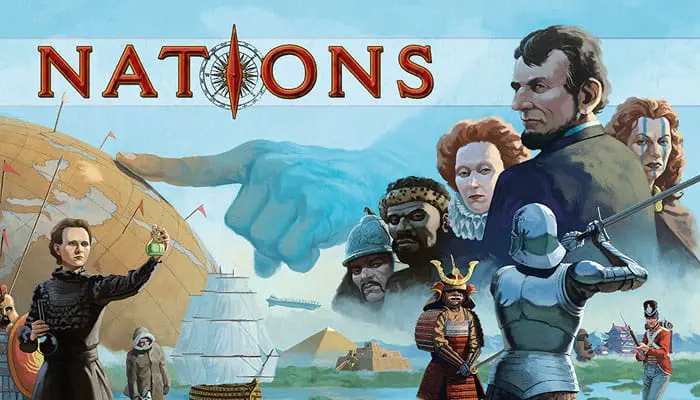
Game Components

- Score Board
- 5 Two-sided Player Boards
- Rulebook
- Progress Board
- 13 workers
- 5 player discs
- Book
- Scoring pad
- Progress Cards
- Event Cards
- Player order cards
- Player aid tile
- Solo Event tiles
- Food, Stone, Gold, VP tokens
- War, Roumd, Architect, Used tokens
- 6 side die
Setup
Each player takes a Player Board. When playing for the first time you should use A-sides. When playing with B-sides, Player boards are chosen in reverse player order after Scoring and Progress Board setup.
Shuffle the Event Card decks for each age separately. Place the Event Card decks for ages II-IV aside for now. For your first game leave out Advanced and Expert cards.
The 50-Book tokens will be taken by players completing a full circle of the Heritage Track. Place the shuffled Event Card deck for age I next to the Scoring Board.
Place the Architects next to the Scoring Board. This is called the "Architect Supply". The Scoring Board and the Progress Board are placed in the middle of the table next to each other.
Shuffle the Progress Card decks for each age separately. Place the Progress Card decks for ages II-IV aside for now. For your first game leave out Advanced and Expert cards. Place the shuffled Progress Card deck for age I next to the Progress Board.
Place the resource markers within easy reach of all players. This is called the Resource Supply.
Scoring Board Setup

Step 1: Randomly select player order. The first player places her disk on number 1 of the Heritage Track, followed by each player in player order, i.e. the last player's disk is highest on the track. Each player also places another disk on corresponding numbers of the Player Order Track.
Step 2: Place the white round marker on the "A" -space of Age I (Antiquity).
Step 3: Each player selects the difficulty level they wish to play by placing a player disk of their colour on the desired level. Play on Prince in your first game.
Step 4: Each player places one player disk of their color on value 0 of the Military Strength Track. Each player's Military Strength will be measured on this track through the game. Any Military Strength above 40 is counted as 40.
Step 5: Place the black War Marker in this slot. If a player buys a War during a round, the Progress Card representing the War will be placed here and the War Marker is moved on the Military.
Step 6: Each player places one player disk of their colour on value 0 of the Stability Track. Each player's Stability will be measured on this track through the game. Any Stability above 15 is counted as 15, and any Stability below -3 is placed on -∞ but counted as its real value.
Step 7: Place up to three Architects (depending on the number of players) on the squares reserved for them. Note that further Architects may be added depending on the Event Card for the round.
Player Board Setup
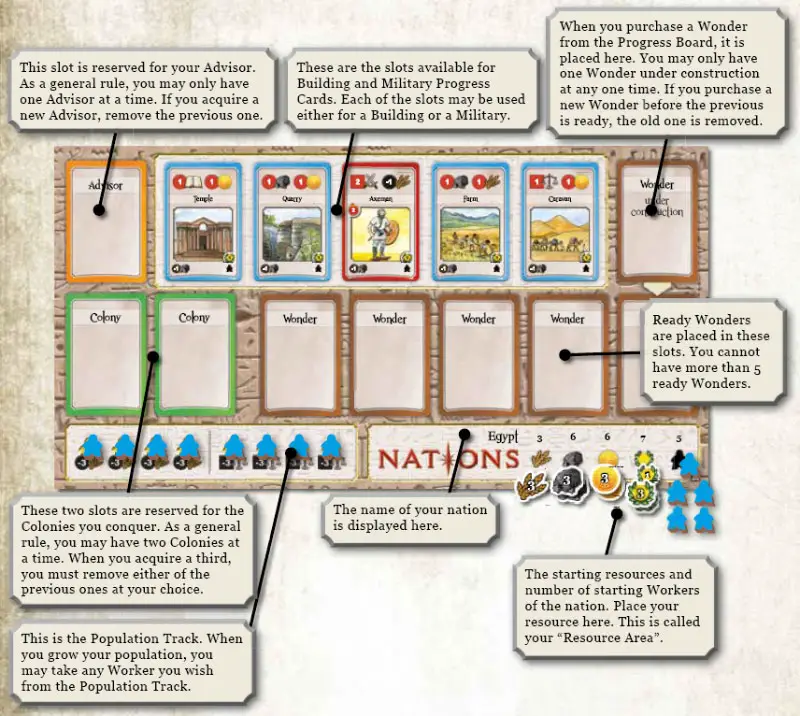
Game Play
During each round, the following phases take place in the order presented below:
I. Maintenance Phase
- Round Marker
- Progress Cards
- Growth
- New Events
- Architects
II. Action Phase
A. Buy Progress Card
B. Deploy
C. Hire Architect
D. Special action
III. Resolution Phase
- Production
- Player order
- War
- Events
- Famine
- Score if end of age
I. Maintenance Phase
Do the following steps in order.
1. Round Marker
Move the round marker to the next space on the Round Track. Let it stay on space A in the first round of the game.

2. Progress Cards
Remove any remaining Progress Cards on row 1 and 2 of the Progress Board. Then move all remaining cards from row 3 to row 1. To make it clear what cards are old move these old cards from row 3 as far left as possible on row 1.
Draw new Progress Cards from the Progress Card deck specific to the current age and fill all empty spaces on the Progress Board in use with the number of players in the game. With 1-2 players use 4 columns, with 3 players use 5 columns, with 4 players use 6 columns and with 5 players use 7 columns.
In the first round of the game all used spaces are fi lled once, no cards are cleared.
Note that cards from previous ages are not automatically removed, so for example in the first round of Medieval some Antiquity cards will be on row 1 (unless all cards on row 3 were bought in the previous round).

3. Growth
Every nation, in reverse player order, decides to either grow its population or take bonus resources. To grow your population, take a Worker of your choice from the Population Track into your Resource Area. Every Worker taken from the Population Track either reduces your Stability immediately by 3 or causes you to pay 3 Food during Production in the Resolution Phase.
Nations that take bonus resources choose either Food, Stone or Gold. Gain as much of that resource as your difficulty level (for example, 3 for Prince). It is not possible to mix and take some from one resource and some from another.

4. New Events
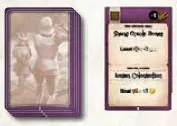
Draw one Event Card from the current age and place it face up on the historical event space on the Score Board. The events on the Event Card will be resolved during the Resolution Phase.
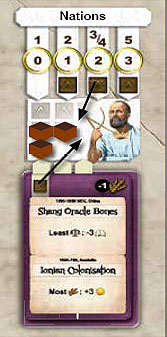
5. Architects
Move any remaining Architects from the Architects space on the Score Board to the Architect supply, so that the Architects space is empty. Place 0 (1 player), 1 (2 players), 2 (3-4 players) or 3 (5 players) new Architects there, and add as many as shown at the top of the Event Card. If you placed Architects based on the number of players during set-up, on the first round of play only add those based on the Event Card.
II. Action Phase
This is the main phase of each round. Nations take one action each in player order until all players have passed. Once a player has passed, she may not resume taking actions later during the round.
A. Buy a Progress Card
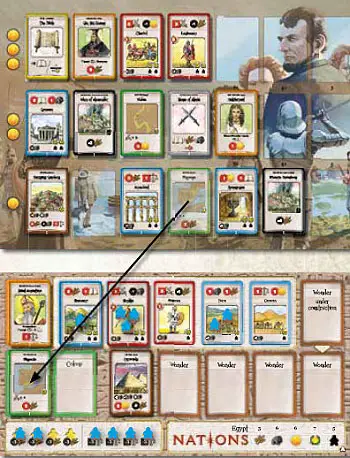
To buy a Progress Card, take the card from the Progress Board, pay the price in Gold shown on the left of the row in which the card was located and immediately use the card.
You cannot place Progress Cards you buy in reserve. Depending on the type of card bought, you either:
- place it on your Player Board on a space with the same border color (Buildings/Military, Advisors, Colonies and Wonders);
- remove it after resolving its effect (Battles and Golden Ages); or
- place it in the War" slot on the Scoring Board (Wars).
When placing a card on your Player Board, the number of spaces per type is limited to what you have on your Player Board. If you have no free spaces for that type of card remove an old card from play to make room for the new card. The removed cards, including the pre-printed cards on the Player Board (if covered with a new card), can never be used again.
The cards you buy only aff ect yourself; cards that can aff ect others will say so. Special actions provided by cards you have can be used any number of times, while cards that can be used limited number of times per round will say so.
Building

New Buildings can replace existing Buildings and Military so you can, for example, have 5 different Buildings at the same time. When an existing Building is removed by a new Military or Building, the Workers on the old Building are undeployed (moved back to your Resource Area).
In the Resolution Phase, each Worker deployed on the Building produces the amount of resources stated on the top of the card. Any Stability adjustments are performed immediately.
Buildings without Workers have no effect.
Military

New Military can replace old Military and Buildings so you can, for example, have 3 Military cards at the same time. When an existing Military is replaced by a new Military or Building, the Workers on the old Military are undeployed (moved back to your Resource Area). Each Worker deployed on the Military immediately increases the Military Strength by the amount stated on the top of the card. If the Military has an upkeep cost, adjust it immediately (Stability) or pay it during the Resolution Phase (resources).
Each Military also has a Raid value. The Raid value of the Military can be used for Battles if the card has at least one deployed Worker. Multiple Workers on the card do not increase its Raid value. Military without Workers has no effect.
Colony
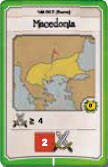
Colonies have a Military Strength requirement. To buy a Colony you must meet or exceed its Military Strength requirement. Once you have bought a Colony the Military Strength requirement no longer matters; your Military Strength may fall below it without any effects on your acquired Colony. Bought Colonies are immediately in effect.
War

Any player can buy a War as an action. Each round only a single War may be bought. Once a War is bought no nation may buy another War. When bought, it is placed on the War space of the Score Board. Place the War marker on the same Military Strength as the nation who bought the War. In the Resolution Phase, any nation with less Military Strength than the War will suffer a defeat.
The War marker does not move with the nation that bought it, so if that nation increases its Military Strength the War marker stays where it is. If the nation that bought the War later decreases its Military Strength that nation may also be defeated by the War.
Battle

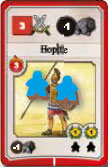
When you buy a Battle you immediately gain either Books, Food or Stone and then remove the card. You decide what type, but you have to choose only one type. How much you gain depends on the Raid value of your best military (your best military card that has at least one Worker on it). Your Raid value does not increase by having more than one Worker deployed on a raiding Military.
You may only buy Battle if you have at least one Worker deployed on a Military.
Wonder

Wonders bought from the Progress Board are placed on the "Wonder under construction" space of your Player Board. You may only build on one Wonder at a time. If you buy a new Wonder while currently constructing another, the old Wonder is removed and all Architects on it are lost.
When a Wonder is ready (i.e. the construction of its last section is completed), its special effects are activated and it will produce in the Resolution Phase (if it has resource production capability).
Advisor
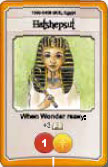
A bought Advisor is placed on the Player Board in the slot reserved for Advisors. You can have just one Advisor at a time unless you have a Progress Card stating otherwise.
Golden age
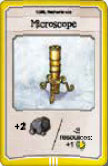
When you buy a Golden Age you immediately gain either the resources printed on the card or 1VP and then remove the card. You decide what you gain, but you have to choose only one of the options.
To gain 1VP you must pay the number of resources shown in any combination of Stone, Gold, Food or Books.
If you have a Golden Age bonus you will either get more of the resource or pay fewer resources for a VP; how much depends on the bonus number. Multiple bonuses are added, but a VP can not cost less than 0.
B. Deploy a Worker
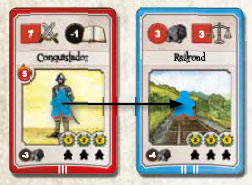
An empty Building or Military does nothing. To deploy a Worker on a Building or Military, place the Worker on the card and pay its deployment cost in Stone. The Worker must be taken from your Resource Area (but you can undeploy from another Building or Military just before taking this action).
You can place several Workers on a Building or Military, multiplying the card's effect, but only one Worker can be deployed per turn.
A Worker can be undeployed from a Building or Military at any time during your turn. Undeployment is not an action so you can do it for example just before passing or buying a War. You can undeploy multiple Workers at once. Workers stay on cards until you undeploy them.
The effect of each deployed Worker is displayed at the top of the Building or Military it is deployed on. Buildings produce resources and/or increase your Stability. Military increases your Military Strength and consumes some resource and/or decreases Stability.
Workers can only be deployed on Buildings and Military. When a Worker is undeployed from a card, its benefit is lost immediately. Workers cannot be deployed on Colonies, Wonders or Advisors.
C. Hire Architect
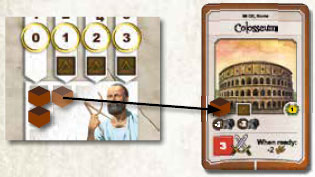
A Wonder must be built in sections while it is placed on the Wonder under construction"-space. To construct a section of a Wonder, take an Architect from the Score Board, place it on the leftmost free section of the Wonder under construction and pay the section's construction cost in Stone.
If there are no Architects available, you do not have a Wonder under construction or you do not have enough Stone to pay the next section's cost, you cannot choose this action.
When the last section of the Wonder is constructed, the Wonder is ready. Move it immediately to a Wonder space on your Player Board. You may place it on top of another ready Wonder which is destroyed in the process. Return the Architect(s) to Architect Supply.
Certain cards allow additional Architects to be used in addition to those available to all nations. Place extra Architects from the supply on it when buying such a card or take from the supply when using such effects from an event.
D. Special Action
If you have progress cards on your player board that have special actions, you can use one of them as an action.
Place a  marker on a Progress Card when you have used a special action on it, if the number of times it can be used is limited.
marker on a Progress Card when you have used a special action on it, if the number of times it can be used is limited.
III. Resolution Phase
Do the following steps in order.
1. Production
All nations produce simultaneously. Calculate production and consumption for each resource in the order shown on the player aid cards (Gold, Food, Stone, Books). Sum up your total production and consumption of each resource from your Player Board, multiplying production and consumption for each Worker on a Building and Military.
Take (or pay) that much of each resource and place them in your resource area.
If your total Books exceed 50, take a 50 Books tile and continue counting from 0.
All nations in revolt (with negative Stability) lose 1 Book per negative point and also 1 VP regardless of how many negative points they have.
If you do not have enough Stone, Gold or Food, lose 1 Book for each missing. In addition, lose 1 VP for each. If your total amount of Books is at 0 and should be reduced below, it stays at 0 and you lose one VP plus one other resource of your choice per Book you should have lost. You can not lose more VP if you are at 0.
Example: If you should pay 5 stone but only have 2, you lose those 2, 1 VP, and 3 books.
2. Player order
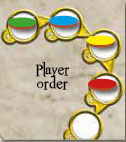
Determine the player order for the next round. Player order is determined in accordance with Military Strength with the player with the highest Military Strength going first, second highest going second and so on. In the case of a tie, higher Stability acts as a tiebreaker. If there is still a tie, the order between the tied players from the previous round remains.
Redistribute the player order cards and update the player order track on the Score Board.
3. War
Nations matching or exceeding the Strength of the War are unaffected. Nations with lower Military Strength than the War suffer a defeat. The amount of resources each defeated nation has to pay is shown on the bottom of the War card.
If a defeated nation has a Stability that is higher than 0, its resource loss is reduced by that number. It is possible to lose no resources to a War even if defeated. However, all defeated nations lose 1 VP as shown on the War card, even if they did not lose any resources. The VP loss cannot be mitigated by Stability. Then remove the War and return the War marker to the War space.
4. Events

Determine the effect of each Event on the Event Card in order from top to bottom.
If two or more nations tie for strongest, none get the benefit.
If two or more nations tie for lowest (lowest Military Strength is also called the weakest), all suffer the penalty in full. All nations with negative Stability are considered to tie for lowest Stability.
Some Events change the player order. If several nations are affected by such an Event, resolve it in player order. Whenever multiple nations have a choice, the choice is made in reverse player order (last in player order goes first). After all have chosen, the event happens at the same time for all. Some Events increase or decrease the number of Workers for nations.
Gained Workers are always taken from the Population Track on the Player Board, and lost Workers are placed back on an empty space there. Which track to take from or place back to are chosen by the player. Event effects can only be used once.
5. Famine
All nations must pay the famine cost in Food shown at the top of the Historical Events card.

6. Score at the end of each age
At the end of an age, each nation gains a VP for each nation that has accumulated fewer Books than itself.
Example: At the end of Antiquity Blue has 13 Books, Yellow 11, Green 11 and Red 4. Blue gains 3 VP, Yellow and Green 1 VP and Red 0 VP.

End of the game
Victory points are awarded normally for accumulated Books at the end of Resolution Phase in round 8. After that the final scoring is done and the winner celebrated.
Final scoring
At the end of the game, record the score of each nation on the score pad as follows:
A. Game VP
Game VP is the sum of the value of the
 tokens that you have at the end of the game (those you started with plus or minus any gained throughout the game).
tokens that you have at the end of the game (those you started with plus or minus any gained throughout the game).B. Colonies

Add the VPs gained from your Colonies.
C. Wonders

Add VPs gained from your Wonders, including any special VP bonus they might award.
D. Buildings
 and Military
and Military 
Sum up the VPs gained from your Workers deployed on Buildings and Military. The number of VPs for a deployed Worker can be seen below the picture of the Building and Military. The first Worker on a card gives the leftmost VP value, the second Worker the next and so on. If there are more Workers than VP symbols on the card, the excess Workers gain no VPs for you. Buildings and Military without Workers do not yield any VPs.
E. Resources
Add up the value of your remaining Gold, Food and Stone tokens as well as your accumulated Books. To that figure, add your current Military Strength and Stability. For each full 10 of this sum you get 1 VP.
Add up the total number. The nation with the most VPs is the winner. Any ties are resolved in player order.
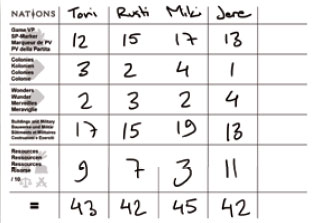
Example: 3 Stone, 7 Gold, 5 Food, 6 Books, 10 Military Strength and 6 Stability sums up to 37, and gives you 3 VP.
Continue Reading

